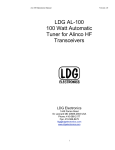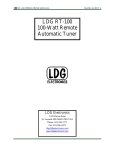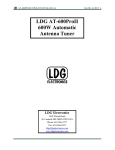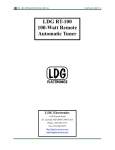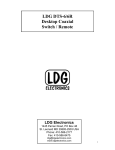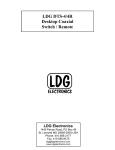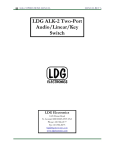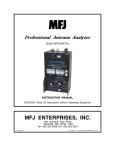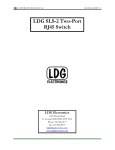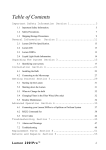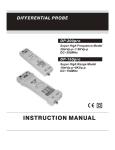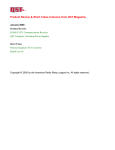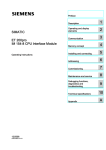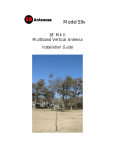Download LDG AT-200Pro Automatic Antenna Tuner
Transcript
AT-200Pro Automatic Antenna Tuner Manual Version 1.0 LDG Electronics 1445 Parran Road, PO Box 48 St. Leonard MD 20685-2903 USA Phone: 410-586-2177 Fax: 410586-8475 [email protected] www.ldgelectronics.com LDG AT-200Pro Automatic Antenna Tuner Introduction Jumpstart, or “Real hams don’t read manuals!” Specifications 4 3 4 An important word about power levels Getting To Know Your AT-200Pro Installation Operation 4 5 7 8 Basic operation Tuning 8 11 Auto and Semi-Auto Modes 12 Memory Tuning 12 Full Tuning Cycle (Long press) 12 Memory Tuning Cycle (Medium press) 13 Bypass mode (Short press) 13 Power and SWR Indication 14 Off Mode 14 Advanced Operation 14 Operation with an LDG radio interface: Application Notes 15 17 Mobile operation 17 When to use Auto mode 17 When to use Peak mode 18 When to turn the LEDs off 18 RF Noise 18 MARS/CAP coverage 18 Error indications Theory Of Operation Some basic ideas about impedance Transmitters, transmission lines, antennas and impedance The LDG AT-200Pro A word about tuning etiquette Care and Maintenance Technical Support Warranty and Service Firmware upgrades Feedback 18 19 19 19 21 22 22 22 22 22 23 2 Introduction Congratulations on selecting the LDG AT-200Pro tuner. The AT-200Pro provides fully automatic, any mode antenna tuning across the entire HF range plus 6 meters at power levels to 250 watts. It will tune dipoles, verticals, Yagis or virtually any coax-fed antenna. It will match an amazing range of antennas and impedances, far greater than some other tuners you may have considered. Also, it consumes very little power making it suitable for battery-powered operations. While resembling earlier LDG tuners in overall layout and function, the AT-200Pro represents a quantum leap in features and performance. Enhanced tuning algorithms provide much faster, precise and consistent tuning. Automatic tuning is now available during transmission, even SSB, and many user-settable options are accessible from the front panel. The two large LED meters provide simultaneous readings of power and SWR, and readouts of internal states and settings. LDG pioneered the automatic, wide-range switched-L tuner in 1995. From its laboratories near the nation’s capitol, LDG continues to define the state of the art in this field with innovative automatic tuners and related products for every amateur need. Jumpstart, or “Real hams don’t read manuals!” Ok, but at least read this one section before you transmit: 1. Connect the antenna jack on your transceiver to the "Tx" jack on your AT-200Pro tuner using a 50 Ohm coaxial cable jumper of appropriate power handling capability. 2. Connect your 50 Ohm antenna coax lead to the "Ant 1" jack on the back of your AT200Pro. 3. Connect your AT-200Pro to a source of 11 - 16 volts DC @ 750mA via the 2.5 by 5.5 mm power jack on the back (center positive). 4. Power up your transceiver and select the desired operating frequency. 5. Begin transmitting, any mode1. 6. Wait for the tuning cycle to end. 7. You’re now ready to operate. 1 If using SSB mode, simply speak into the microphone. You can tune while transmitting up to 125 watts if your transceiver has a “roll-back circuit” to protect it from high SWR. If it does not have a roll-back circuit, limit power when tuning to 25 watts to avoid damage to your transmitter or transceiver. 3 Specifications • 0 to 250 watts SSB and CW peak power, 200 watts continuous (100 watts on 6M) • Easy to read LED bargraph display for RF power, SWR and status • 16,000 "3-D" memories for instantaneous band changing • Two position antenna switch with memories for four antennas on each position • Tuning time: 0.5 to 6 seconds full tune, < 0.2 second memory tune • Built in frequency counter for memory operation • Frequency coverage: 1.8 to 54.0 MHz. • Tunes 6 to 1000 ohm loads (16 to 150 ohms on 6M), 6 to 4000 ohms with optional 4:1 Balun (LDG RBA-1) • For Dipoles, Verticals, Vs, Beams or and Coax Fed Antenna • Optional external Balun allows tuning of random length, long wire or ladder line fed antennas • Optional interfaces for Icom, Alinco, Kenwood and Yaesu available • Power requirements: 11 to 15 volts DC at 750 mA max during tuning • Enclosure: 9 x 7 x 2 inches • Weight: 2 pound An important word about power levels The AT-200Pro is rated at 250 watts maximum power input at most. Many ham transmitters and transceivers, and virtually all amplifiers, output well over 250 watts. Power levels significantly exceeding specifications will definitely damage or destroy your AT-200Pro. If your tuner fails during overload, it could damage your transmitter or transceiver. Be sure to observe the specified power limitations. IMPORTANT SAFETY WARNING Never install antennas over or near power lines. You can be seriously injured or killed if any part of the antenna, support or transmission line touches a power line. Always follow this antenna safety rule: the distance to the nearest power line should be at least twice the length of the longest antenna or support dimension. 4 Getting To Know Your AT-200Pro Your AT-200Pro is a quality, precision instrument that will give you many years of outstanding service; take a few minutes to get to know it. • Your AT-200Pro can be used with any transceiver or transmitter with coax output operating in the HF range at no more than 250 watts output. You can set the unit to tune automatically whenever the SWR exceeds a set value, or you can set it to tune semi-automatically when you start a tuning cycle by pressing the Tune button. The front panel presents seven pushbutton controls, and two LED meters: • • • • • • • • • • Power: turns the AT-200Pro on and off. When off, the tuner is in bypass. When turned on, the tuner automatically resets to the last tuned setting Tune: Initiates either a memory or full tuning cycle, and also places the tuner in "bypass" mode. Ant: Selects one of two antennas C Up: Manually increase capacitance C Dn: Manually decrease capacitance L Up: Manually increase inductance L Dn: Manually decrease capacitance Func: Selects alternate functions for the other six buttons (see below) PWR: LED meter indicates forward power in 25 and 250 watt ranges SWR: LED meter indicates SWR while tuning or transmitting After tuning, it automatically enters a “deep sleep” state in which it draws only about 10 milliamps. The tuner will automatically "wake up" the next time you start a tuning cycle, when RF is present, a button is pushed or when an automatic cycle is needed. Tuning memories are stored indefinitely in EEPROM memory. The AT-200Pro has a total of 16,000 "3-D" frequency memories. There are 8,000 memories for each of the two antenna ports, 2,000 tuning settings for each of four separate antennas. When you transmit near a previously tuned frequency, you can use “Memory Tune” to reset the tuner in only a fraction of a second. The process of storing tuning data in memory is completely automatic; your AT-200Pro “learns” as you use it, adapting itself to all of the bands and frequencies you use. 5 On the back panel, there are six connectors: • • • • • • RF input (marked “Tx”, standard SO-239 socket) Antenna connector 1 (marked "Ant 1", standard SO-239 socket) Antenna connector 2 (marked "Ant 2", standard SO-239 socket) DC power in (2.5 by 5.5 mm power jack marked "Power", center positive) Stereo 1/8” jack marked "Radio" for connecting a control cable to a compatible transceiver Ground connector (wing nut) 6 Installation Your AT-200Pro tuner is intended for indoor use only; it is not water resistant. If you use it outdoors (Field Day, for example) you must protect it from rain. The AT-200Pro is designed for use with coax-fed antennas. If you wish to use it with longwires or antennas fed with a balanced transmission line (e.g., ladder line), an external balun is required; either the LDG RBA-4:1 or RBA-1:1 is ideal, depending on the antenna and transmission line used. Always turn your radio off before plugging or unplugging anything. Your radio may be damaged if you connect or disconnect a cable with the unit powered up. Note that some radios do not power down the tuner even when the radio is turned off. To be safe, unplug the tuner's power connector before plugging or unplugging anything else. Connect the HF antenna jack on your transmitter or transceiver to the Tx jack on the back of your AT-200Pro tuner using a coax jumper with standard PL-259 plugs (not provided). Properly soldered connectors will be far more satisfactory and reliable than crimp-on or “solderless” connectors. Attach your antenna lead-in coax to either the Ant 1 or Ant 2 jack on the back of your AT-200Pro tuner. You will select the appropriate antenna from the front panel (see Operating Instructions). Your AT-200Pro can interface directly with many popular transceivers, enabling their “Tune” button to start a tuning cycle, and in most cases providing power to the tuner. Optional cables and interface adapters are available from LDG for many Alinco, Icom, Kenwood and Yaesu transceivers. If you are using a transceiver interface, plug the adapter into the appropriate accessory jack on the radio, and plug the stereo plug on the interface adapter cable into the Radio Interface jack on the back of the tuner. If you are not using an interface cable to a radio capable of powering the tuner, connect your AT200Pro to a source of DC power capable of providing 11 – 15 volts DC at 750 mA, using the provided 2.5x5.5mm coaxial cable (center positive). If your radio is powered by 12 VDC, you can use the same power supply for the AT-200Pro, providing the power supply can source the extra 750 mA required by the tuner during a tuning cycle. Grounding your tuner will enhance its performance and safety. LDG recommends that you connect your tuner to a suitable ground; a common ground rod connected to buried radials is preferred, but a single ground rod, a cold water pipe or the screw that holds the cover on an AC outlet can provide a serviceable ground. LDG strongly recommends that you use a properly installed, high quality lightning arrestor on all antenna cables. 7 Operation Basic operation All functions are controlled through the seven front panel buttons. Each function is invoked when the key is released. Some commands are indicated by the length of time you hold a button before releasing it. There are three lengths of press: short (less than 0.5 seconds), medium (0.5 – 2.5 seconds) and long (more than 2.5 seconds). This sounds a lot more complicated than it actually is; this interface will quickly become familiar and easy. Setting Options All settings are retained in EEPROM memory indefinitely, even if power is disconnected. Separate settings are stored for each antenna, except for Antenna selection. Startup Options Your AT-200Pro has two startup commands, invoked by holding down one or more keys while applying DC power to the unit (usually by plugging in the coaxial power connector). Version display: Press and hold Func while powering up. This will display the version number of the firmware in your tuner on the LED meters. The first digit of the version number is displayed on the PWR meter, the second on the SWR meter. The LEDs use a one-of-eight display, indicating 1, 2, 3, etc from right to left. In the example below, version 1.3 is displayed (this is just an example; your version number may be different). Version Display All Reset: Press and hold Func+Ant+Tune while powering up. This will reset the unit to factory defaults, and will erase all frequency memories. 8 Menu Options Your AT-200Pro offers several options to adapt the tuner to your operations. Many functions are controlled using the Func button. Press and release this button to place the tuner in Function mode. You will see an "up arrow" display on the LED meters, indicating Function mode. Function mode will time out after a few seconds, and a "down arrow" display will appear; subsequent key presses must occur while function mode is still active. You can also cancel the function mode by momentarily pressing the Func button a second time. Function Mode On Function Mode Off The status check functions require you to press and hold the Func button. The following display is shown during function hold: Function Hold 9 Peak Mode On/Off: the LED wattmeter will read in average or peak watts. Average mode is most suitable for 100% duty cycle modes like FM or RTTY. Peak mode is most suitable for modes in which the amplitude varies, such as SSB or AM. The default is average mode. To toggle between these two modes, press and release the Func button. Then press and release the C Up button. You will see the highest power LED "float" behind the others, indicating peak mode. Repeat this process to toggle back to Average mode, shown by the absence of the "floating" LED. Peak Mode Wattmeter Scale: the LED wattmeter will indicate 25 or 250 watts maximum; the default is 250 watts. You will probably want to use the 12.5 watt scale when operating QRP to provide greater resolution. To toggle between these two scales, press and release the Func button. Then press and release the L Up button. The LED marked "20" or "250" will light momentarily to indicate the 25 or 250 watt scale, respectively. The rightmost LED blinks at 30 or 300 watt over-range. 25 Watt Scale 250 Watt Scale Automatic Tuning Mode: you can set your AT-200Pro to automatically begin a tuning cycle whenever the SWR exceeds a value you set, or you can set it to semi-automatic, to tune only when you begin a tuning cycle by pressing the Tune button. The default is Auto mode. To toggle between Auto and Semi-auto modes, press and release the Func button. Then, press and release the C Dn button. The LEDs will show the following patterns to indicate Auto and Semi mode: Auto Mode Semi Mode 10 Auto Tune Threshold: You can set the SWR at which an automatic tuning cycle will begin. press and release the Func button. Then press and release the L Dn button. The SWR meter will show the new setting. Repeat this sequence to cycle through the available values (1.1 - 3.5). The default value is 2.0. The example below shows the threshold set to 1.7. Auto Threshold Display High/Low Impedance Toggle: You can manually set your AT-200Pro for Hi-Z or Lo-Z antennas. Press and release the Func button. While this function is rarely used, it is available for the more advanced user to temporarily set the tuner to an LC or CL configuration. To toggle the Hi/Lo-Z setting, press and release the Ant button. The LEDs will show the following patterns to indicate low and high impedance. This setting is relevant only when you are manually adjusting the match using the C and L buttons. It is automatically set when you run any automatic tuning cycle. Low Impedance High Impedance Antenna Selection: Press the Ant button to toggle between Ant 1 and Ant 2; the default is Ant 1. The LED display points toward the selected antenna connector (as viewed from the front of the unit). You cannot change antennas while transmitting; the antenna selection function is disabled when RF is present. When you change antennas, the tuner references the last frequency used on that antenna, and recalls tuning settings for that frequency, if any. Antenna 1 Antenna 2 11 Tuning Auto and Semi-Auto Modes In Auto mode (see section on selection Auto or Semi mode) the tuner will begin a tuning cycle whenever the SWR exceeds the value you set (see section on setting autotune threshold). In Semi mode a tuning cycle begins only when you start one by pressing the Tune button, regardless of SWR. You can also start a Semi tuning cycle while the tuner is in Auto mode. Your personal operating practices will determine which mode is best for you. The default mode is Auto. Auto mode tuning works well while you are transmitting in SSB, AM, CW or any digital mode. Recent advances in LDG's tuning algorithms allow your AT-200Pro to tune effectively even with a varying RF signal. This means that as you change frequencies, antennas or bands, you don't have to make a separate tuning transmission; just start talking and your AT-200Pro will match up in as little as 0.2 seconds. Memory Tuning This is pretty amazing, so lash yourself to the mast; your AT-200Pro has 16,000 3-D frequency memories; 8,000 memories for each antenna port. They store the tuning parameters for each frequency as you tune; that's 2,000 memories for each of four different antennas on each of the two ports. You can use a wide variety of antennas, connecting them to the two antenna ports as needed. Think of it; you could be using a Yagi, Quad, Loop or Vee on the Ant A port, and a Dipole, Vertical, Longwire or J-Pole on the Ant B port, connecting them as needed (or switching them through an external coax switch), and each of them will have 2,000 dedicated memories. When you transmit on or near a memorized frequency again, the tuner finds the best match for that port and antenna and resets those parameters in a fraction of a second, much faster than a full tuning cycle. This will work best if you always use a particular antenna on the same antenna port each time. When you tune, you can select between a Memory tune and a Full tune. If you select Memory tune and there is no appropriate memory data, the tuner will automatically begin a full tuning cycle. Tuning parameters are stored in EEPROM memory, and are retained indefinitely, even if power is removed. Full Tuning Cycle (Long press) Set your transmitter or transceiver to SSB, AM, FM, CW or Packet mode, and a power level of no more than 125 watts if your radio has a power rollback circuit. If your radio lacks a rollback circuit (see your owner’s manual), set the power level to no more than 25 watts. Press the PTT switch on the microphone (close key on CW) to transmit a carrier, or simply begin talking on SSB or AM. While transmitting, press and hold the Tune button on the front of your AT-200Pro for at least 2.5 seconds. Long Press > 2.5 Sec for Manual Tune 12 Release the Tune button; an automatic tuning cycle will begin. You will hear the relays in your AT-200Pro as they switch in and out seeking a match; they make a buzzing noise. The tuning cycle will end in a few seconds with the SWR LED meter indicating the final match. At the end of a full tuning cycle, the SWR LEDs will scan inward from both ends to indicate a successful tune to an SWR of less than 1.1.2 Unkey your transmitter or transceiver and reset to your desired power if you changed for tuning − you’re ready to operate. The new tuning parameters are stored for the present operating frequency, replacing any parameters that were previously stored for that frequency. Memory Tuning Cycle (Medium press) If you are tuning near a frequency at which you have already completed a tuning cycle, you can reset the tuner very quickly by using a Memory Tuning Cycle. Key your transmitter as described above, and press and hold the Tune button for .5 to 2.5 seconds, then release. The tuner will automatically check for a saved tuning setting, and if present will restore that setting in a small fraction of a second. If no tuned setting is saved near the present frequency, the tuner will begin a full tuning cycle, saving the result when finished for future operation on that frequency. In this way, your AT-200Pro “learns”; the longer you use it, the more closely it adapts itself to the bands and frequencies you use. You will probably use Memory Tuning most of the time; it takes advantage of any stored tuning settings, but automatically defaults to a Full Tuning cycle if no stored data is available. Memory frequency step size varies with band. Steps are very small on the 75 meter band to accommodate the expected higher Q of most antennas, whereas the step size is somewhat larger on 10 meters where antenna Q is usually lower. Medium Press > .5 Sec for Auto Tune Bypass mode (Short press) To place your AT-200Pro in bypass mode, press the Tune button less than a half-second. The tuner will switch to bypass. All LEDs will flash once to confirm bypass mode. In bypass mode RF from your transmitter goes directly to the antenna with no matching. A second short press toggles the tuner back to its last tuned setting; the LEDs show which C and L relays are energized. Bypass followed by Func+Tune will clear the present memory. Bypass mode is not saved when you power down. On the next power up, the tuner will reset the last tuned settings. You can if you wish press Func-Tune to save the bypass setting, erasing the memory for that frequency. 2 LDG's chief engineer, a fan of Snoopy in the Peanuts comic strip, calls this the "Happy Dance". 13 Power and SWR Indication During a tuning cycle the Power and SWR LED meter indicate forward power and the present SWR, respectively. If you are using a transmitter or transceiver with SWR rollback protection, you will see the forward power vary up and down quite a bit during a tuning cycle. During transmit, both forward power and SWR are displayed if this option is selected in the startup options. When no LEDs are lit on the SWR meter when RF is present, it means that the SWR is less than 1.1. When the LED segment labeled 1.1 is lit, it means that the SWR is between 1.1 and 1.3. The 1.3 LED indicates an SWR between 1.3 and 1.5, and so on. Read each LED segment to mean "equal to or greater than the marked SWR, but less than the next higher marked SWR". Off Mode When any tuning cycle ends, the tuner automatically enters a “deep sleep” state in which it draws about 10 milliamps. The tuner will automatically “wake up” the next time you start a tuning cycle, when RF is present, a button is pressed or when an automatic tuning cycle is required, if this option is selected. The tuner enters Bypass mode when you turn it off. Advanced Operation Manual adjustments In rare cases, it may be desirable to manually adjust the match after a tuning cycle. This will happen most often with antennas that are far from resonance at the operating frequency. The C Up, C Dn, L Up and L Dn buttons increase and decrease capacitance and inductance, respectively. Momentarily press any of these buttons to see the present setting; the value is indicated on the display (C on the upper display, L on the lower), left-justified (that is, the lowest order relay is shown on the left). To changes these values, press repeatedly or hold any of these buttons; you will see the value change. Then, key your transmitter to observe the achieved SWR on the SWR meter. You can also manually change C and L as you transmit, observing the SWR on the meter; however, the C and L values are not displayed in this case. Frankly, you won't use the manual adjustments very much; your AT-200Pro is very, very good at finding a match. These functions are included only to provide you with the maximum utility and flexibility. After manually adjusting the match, you can manually store the tuning parameters for the present frequency; press the Func button, then the Tune button. The parameters are stored for later recall, replacing any previously saved parameters for that frequency. Status Query You can query the status of most settings by pressing and holding the Func button while pressing the relevant setting button. For example, to check the power scale of the PWR meter, press and hold the Func key while pressing the L Up button. The PWR meter will indicate the present scale setting without changing it. When done, release all buttons. Other status queries include: • • • • • Ant: Presently selected antenna C Up: Present PWR meter mode C Dn: Present tune mode (Auto or Semi) L Up: Present PWR meter scale L Dn: Present Auto Tune threshold 14 Operation with an LDG radio interface: Operation with an optional LDG radio interface is even simpler. With the interface installed on an Alinco, Icom or Kenwood radio as noted, simply press the Tuner or AT button on the radio; for Yaesu radios, press the Tune button on the tuner to begin an automatic tuning cycle. The radio will automatically transmit a 10 watt carrier, and begin a AT-200Pro tuning cycle. Memory settings will be used if available, otherwise a full tuning cycle will run. When the tuning cycle ends, the radio will revert to its previous mode and power level. Secondary Function Status Check (Func Power-Up (Func + Button) Hold + Button) Function Button Primary Function Tune Manual Tune (Long) Auto Tune (Medium) Bypass (Short) Manually Store Tuning Parameters Present Relay Settings NA Ant Switch between Ant 1 and Ant 2 connectors on back panel Toggle Hi-Lo Impedance Present Antenna [Ant 1] NA C Up Manually increase capacitance Toggle Power meter Peak/Average Present PWR Meter Mode [Avg] NA C Dn Manually decrease capacitance Set Auto/Manual Mode Present Mode (Auto or Semi) [Auto] NA L Up Manually increase inductance Set PWR Meter Scale Present PWR Meter Scale [125 Watts] NA L Dn Manually decrease inductance Set Auto Tuning Threshold SWR Present Auto Tune Threshold [2.0] NA Func Select Alternative Functions For Other Buttons NA NA Version Number Func+ Ant+ Tune NA NA NA All Reset AT-200Pro Command Reference 15 Power NA NA Version Peak/Avg Mtr Mode NA 12/125 Watts Mtr Scale NA Func C Up L Up Hi/Lo Imp Sel Ant NA Auto/Man Tune Mode NA Auto Thresh. Pres. Thresh. NA Ant C Dn L Dn Man Store Rly Settings NA Tune Func + Key Func Hold + Key Hold on Power Up Hold on power-up for All Reset AT-200Pro Key Reference 16 Application Notes Mobile operation The AT-200Pro is perfectly suited to mobile operation. You can install it under the dash along with your transceiver, or remotely in the trunk. The only requirements are that the tuner remain dry, and that you provide a fused source of DC power in accordance with the specifications. The AT-200Pro does not include an internal fuse; you must provide one in the DC line. LDG recommends a 2 Amp "fast blow" fuse. Make sure the tuner is well grounded to the car body. To install the unit under the dash, you can "homebrew" a bracket. You can also use Velcro tape, although the adhesive tends to soften in hot weather. In the trunk, Velcro works well to secure the unit to the trunk floor. Simply run coax from your transceiver to the tuner, run a fused DC line to the tuner and connect your mobile antenna. Simply set the tuner to Automatic mode, and you're ready to go; the tuner will adjust the match as needed whenever you transmit on a new band or frequency. You can observe the progress of the match on your rig's SWR meter, or on the power output meter (not while driving; keep your eyes on the road!). When the reading stops changing, the tuner has finished tuning. Most of the time this will happen very quickly, as the AT-200Pro tunes from memory in less than a second. Xcvr Tuner 2A DC When to use Auto mode Auto mode is most useful when you are often changing frequencies and bands (a contest, for instance). With memory operation, Auto mode will retune almost instantly whenever you transmit on a new frequency. On the other hand, if your antenna SWR is relatively flat across the band of frequencies you're using, retuning might not be necessary, and semi-automatic mode would be preferable. 17 When to use Peak mode Any averaging wattmeter will read correctly only when excited by a steady, unmodulated carrier. Any modulation will cause the reading to vary. Peak mode measures the peak power as the name indicates, and is much steadier in the presence of modulated highs and lows. You will generally want to use Peak mode when using SSB or AM, and average mode when using FM, RTTY or any other 100% duty cycle mode that provides a steady carrier to the wattmeter circuitry. When to turn the LEDs off You can set the LEDs to remain off when transmitting. This will help conserve power when operating from batteries (Field Day, for instance), or when you don't want the distraction of the flashing LEDs. RF Noise The processor in your AT-200Pro creates a certain about of RF noise, which you may notice in your receiver while tuning (only if you are using a separate receiver and not a transceiver) or when information is being displayed in the LED display. This will be most noticeable when operating CW with break-in, while using the Peak power display. This should present no problem, as the Peak mode is not very useful on CW. The extremely short tuning cycle minimizes the impact of the noise; the tuner creates no RF noise while not tuning. MARS/CAP coverage Your AT-200Pro provides tuning continuously over its specified range, not just in the ham bands. This makes it useful for MARS or CAP operation, or any other legal HF operation. Error indications There are four error states that are indicated on the Power LED display by all LEDs flashing twice: 1. No RF is present when a tune command is executed. So, if you press and hold Tune for a full tuning cycle, but no RF is present, the LEDs will flash. 2. RF removed during a tune. If you stop transmitting during a tuning cycle, the LEDs will flash. 3. Full tune below Auto tune threshold. If you start a full tuning cycle when the SWR is already below the Auto tune threshold, the LEDs will flash. 4. Reading over-range. To correct error conditions 1 or 2, simply provide RF for the duration of the tuning cycle. Error condition 3 indicates that a tune cycle is not needed. Error condition 4 indicates power or SWR beyond the range of the meters. 18 Theory Of Operation Some basic ideas about impedance The theory underlying antennas and transmission lines is fairly complex, and in fact employs a mathematical notation called “complex numbers” that have “real” and “imaginary” parts. It is beyond the scope of this manual to present a tutorial on this subject3, but a little background will help you understand what your AT-200Pro is doing, and how it does it. In simple DC circuits, the wire resists the current flow, converting some of it into heat. The relationship between voltage, current and resistance is described by the elegant and well-known “Ohm’s Law”, named for Georg Simon Ohm of Germany, who first discovered it in 1826. In RF circuits, an analogous but far more complicated relationship exists. RF circuits also resist the flow of electricity. However, the presence of capacitive and inductive elements causes the voltage in the circuit to lead or lag the current, respectively. In RF circuits this resistance to the flow of electricity is called “impedance”, and can include all three elements: resistive, capacitive, and inductive. Capacitive Reactance Inductive Reactance The output circuit of your transmitter consists of inductors and capacitors, usually in a series/parallel configuration called a “pi network”. The transmission line can be thought of as a long string of capacitors and inductors in series/parallel, and the antenna is a kind of resonant circuit. At any given RF frequency, each of these can exhibit resistance, and impedance in the form of capacitive or inductive “reactance”. Transmitters, transmission lines, antennas and impedance The output circuit of your transmitter, the transmission line, and the antenna all have a characteristic impedance. For reasons too complicated to go into here, the standard impedance is about 50 ohms resistive, with zero capacitive and inductive components. When all three parts of the system have the same impedance, the system is said to be “matched”, and maximum transfer of power from the transmitter to the antenna occurs. While the transmitter output circuit and transmission line are of fixed, carefully designed impedance, the antenna presents a 50 ohm, nonreactive load only at its natural resonant frequencies. At other frequencies, it will exhibit capacitive or inductive reactance, causing it to have an impedance different from 50 ohms. When the impedance of the antenna is different from that of the transmitter and transmission line, a “mismatch” is said to exist. In this case, some of the RF energy from the transmitter is reflected from the antenna back down the transmission line, and into the transmitter. If this reflected energy is strong enough it can damage the transmitter’s output circuits. The ratio of transmitted to reflected energy is called the “standing wave ratio”, or SWR. An SWR of 1 (sometimes written 1:1) indicates a perfect match. As more energy is reflected, the SWR 3 For a very complete treatment of this subject, see any edition of the ARRL Handbook for Radio Communications (previously the Handbook For Radio Amateurs) 19 rises to 2, 3 or higher. As a general rule, modern solid state transmitters must operate with an SWR of 2 or less. Tube exciters are somewhat more tolerant of high SWR. If your 50 ohm antenna is resonant at your operating frequency, it will show an SWR close to 1. However, this is usually not the case; operators often need to transmit at frequencies other than resonance, resulting in a reactive antenna and a higher SWR. SWR = 1+ R / F 1− R / F where F = Forward power (watts), R = Reflected power (watts) SWR is measured using a device called an “SWR bridge”, inserted in the transmission line between the transmitter and antenna. This circuit measures forward and reverse power from which SWR may be calculated (some meters calculate SWR for you). More advanced units can measure forward and reverse power simultaneously, and show these values and SWR at the same time. An antenna tuner is a device used to cancel out the effects of antenna reactance. Tuners add capacitance to cancel out inductive reactance in the antenna, and vice versa. Simple tuners use variable capacitors and inductors; the operator adjusts them by hand while observing reflected power on the SWR meter until a minimum SWR is reached. Your LDG AT-200Pro automates this process. Reflected Power (Watts) No tuner will fix a bad antenna. If your antenna is far from resonance, the inefficiencies inherent in such operation are inescapable; it’s simple physics. Much of your transmitted power may be dissipated in the tuner as heat, never reaching the antenna at all. A tuner simply “fools” your transmitter into behaving as though the antenna were resonant, avoiding any damage that might otherwise be caused by high reflected power. Your antenna should always be as close to resonance as practical. 2 4 6 8 10 12 14 16 18 20 22 24 26 28 30 32 34 36 38 40 42 44 46 48 50 Forward Power (Watts) 20 30 40 1.92 1.70 1.58 2.62 2.15 1.92 3.42 2.62 2.26 4.44 3.14 2.62 5.83 3.73 3.00 7.87 4.44 3.42 11.24 5.31 3.90 17.94 6.42 4.44 37.97 7.87 5.08 9.90 5.83 12.92 6.74 17.94 7.87 27.96 9.32 57.98 11.24 13.93 17.94 24.63 37.97 77.99 - 50 1.50 1.79 2.06 2.33 2.62 2.92 3.25 3.60 4.00 4.44 4.94 5.51 6.17 6.95 7.87 9.00 10.40 12.20 14.60 17.94 22.96 31.30 47.98 97.99 - 60 1.45 1.70 1.92 2.15 2.38 2.62 2.87 3.14 3.42 3.73 4.07 4.44 4.85 5.31 5.83 6.42 7.09 7.87 8.80 9.90 11.24 12.92 15.08 17.94 21.95 70 1.41 1.63 1.83 2.02 2.22 2.41 2.62 2.83 3.06 3.30 3.55 3.83 4.12 4.44 4.79 5.18 5.60 6.07 6.60 7.19 7.87 8.65 9.56 10.63 11.92 80 1.38 1.58 1.75 1.92 2.09 2.26 2.44 2.62 2.80 3.00 3.21 3.42 3.65 3.90 4.16 4.44 4.75 5.08 5.44 5.83 6.26 6.74 7.27 7.87 8.55 90 1.35 1.53 1.70 1.85 2.00 2.15 2.30 2.46 2.62 2.78 2.96 3.14 3.32 3.52 3.73 3.95 4.19 4.44 4.71 5.00 5.31 5.65 6.02 6.42 6.85 100 1.33 1.50 1.65 1.79 1.92 2.06 2.20 2.33 2.47 2.62 2.77 2.92 3.08 3.25 3.42 3.60 3.80 4.00 4.21 4.44 4.68 4.94 5.22 5.51 5.83 SWR Lookup Table Find SWR at intersection of forward power column and reflected power row. 20 The LDG AT-200Pro In 1995 LDG pioneered a new type of automatic antenna tuner. The LDG design uses banks of fixed capacitors and inductors, switched in and out of the circuit by relays under microprocessor control. A built-in SWR sensor provides feedback; the microprocessor searches the capacitor and inductor banks, seeking the lowest possible SWR. The tuner is a “Switched L” network consisting of series inductors and parallel capacitors. LDG chose the L network for its minimum number of parts and its ability to tune unbalanced loads, such as coax-fed dipoles, verticals, Yagis; in fact, virtually any coax-fed antenna. The inductors are switched in and out of the circuit by relays controlled by the microprocessor. An additional relay switches between high and low impedance ranges. The capacitors are connected to ground with the seven inductor relays. Another relay switches the entire capacitor bank to the input or output side of the inductor. This switching allows the AT200Pro to automatically handle loads that are greater than 50 ohms (high setting) and less than 50 (low setting). All of the relays are sized to handle over 300 watts continuously. The SWR sensor is a variation of the Bruene circuit. This SWR measuring technique is used in most dual-meter and direct-reading SWR meters. Slight modifications were made to the circuit to provide voltages (instead of currents) for the analog-to-digital converters (ADCs) that provide signals proportional to the forward and reverse power levels. The single-lead primary through the center of the sensor transformer provides RF current sampling. Diodes rectify the sample and provide a dc voltage proportional to RF power. Variable resistors calibrate the FORWARD and REVERSE power levels. Once adjusted, the forward and reverse power sensors produce a calibrated DC voltage proportional to the forward and reverse RF power levels. These two voltages are read by the ADCs in the microprocessor. Once in a digital format, the they are used to calculate SWR in real time. The relays operate from DC supplied by via the power input jack. The total current drawn by the AT-200Pro depends primarily on the number of energized relays, with the maximum current drain being approximately 750 mA, but only during the few seconds a tuning cycle is running. At all other times, the tuner is in a “deep sleep” mode drawing only a few milliamps. The last tuned setting is automatically reset on the next power-up. Although the microprocessor’s oscillator runs at 20 MHz. The main tuning routine takes about 75 cycles to make a tuner adjustment and take a new SWR measurement, or 7 milliseconds per tuner adjustment. If running at maximum speed, the microprocessor can try all inductor-capacitor combinations in under 3 seconds. Unfortunately, the mechanical relays can’t react as quickly as the microprocessor, and the tuning speed must be slowed down to compensate for relay settling time. The tuning routine, written in assembly language, uses an algorithm to minimize the number of tuner adjustments. The routine first de-energizes the high/low impedance relay if necessary, then individually steps through the inductors to find a coarse match. With the best inductor selected, the tuner then steps through the individual capacitors to find the best coarse match. If no match is found, the routine repeats the coarse tuning with the high/low impedance relay energized. The routine then fine tunes the capacitors and inductors. The program checks LC combination to see if a 1.5 or lower SWR can be obtained, and stops when it finds a good match. The microprocessor runs a fine tune routine just after the tuner finds a match at an SWR of 1.5 or less. This routine tries to get the SWR as low as possible (not just 1.5); it takes about a half 21 second to run. There is also a quick tune mode. If the swr is below 2.0 when you press the tune button to start a tuning cycle, the tuner will first try a memory tune routine to see if it can achieve a low swr without a complete re-tune. This also takes about a half second to run. If it does not find a good match, then it runs a full tuning routine. A word about tuning etiquette Be sure to use a vacant frequency to tune. With today’s crowded ham bands, this is often difficult. However, do your best to avoid interfering with other hams as you tune. Your AT-200Pro’s very short tuning cycle, as little as a fraction of a second, minimizes the impact of your tuning transmissions. Care and Maintenance Your AT-200Pro tuner is essentially maintenance-free; just be sure to observe the power limits discussed in this manual. The outer case may be cleaned as needed with a soft cloth slightly dampened in household cleaning solution. As with any modern electronic device, your AT200Pro can be damaged by temperature extremes, water, impact or static discharge. LDG strongly recommends that you use a good quality, properly installed lightning arrestor in the antenna lead. Technical Support We are happy to help you with your AT-200Pro. Telephone technical support is available at 410586-2177 weekdays from 9 am to 5pm Eastern Time. Inquiries by Fax at 410-586-8475 are welcome, and prompt e-mail support is available at [email protected]. Warranty and Service Your AT-200Pro is warranted against defects in parts or workmanship for two years from purchase. The warranty does not cover damage due to abuse or exceeding specifications. This warranty applies to the original purchaser only; it is not transferable. A copy of the receipt showing the purchaser’s name and the date of purchase must accompany units returned for warranty service. All returns must be shipped to us pre-paid; we will not accept units with postage due. A return form is provided on our web site for your convenience. If you need to return your AT-200Pro to us for service, package it carefully, keeping in mind that we will re-use your packaging to return the unit to you. Download the return form from our web site, fill it out and return it with your tuner. A self-addressed return-shipping label, while not required, will help insure speedy and accurate delivery of your repaired unit. Include a full description of the problem, along with your name, address and a phone number or e-mail address where we can reach you with any questions. Repairs average about 3 to 6 weeks. We will be glad to service your AT-200Pro after the warranty period has ended. We will notify you of repair charges by phone or e-mail, and bill you after repairs are completed. Firmware upgrades From time to time LDG may release upgraded firmware for the AT-200Pro, refining operation and adding features. Your AT-200Pro is not field programmable; you will have to remove the present chip and replace it with the upgrade chip. You will return the old processor chip to LDG; upgrades will be sold by exchange only. The processor chips are recycled and reprogrammed to 22 minimize future upgrade costs. Upgrades are expected to cost about $10-$20 with chip exchange, and will be announced on our web site when available. Feedback If you have an idea to improve our software or hardware, please send us a description. If we incorporate your idea in the AT-200Pro, we'll send you a free upgrade as a “thank you”. We encourage everyone who uses the AT-200Pro to contact us (card, letter or e-mail preferred) telling us how well it works for you. We are also always looking for photographs of our products in use; we frequently place such pictures on our Web site (www.ldgelectronics.com). 23























